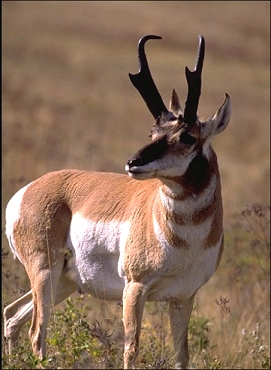

Our speediest Chihuahuan Desert native mammal undoubtedly is the Pronghorn, often called an antelope by non-biologists. Considering that Pronghorns are pretty good-sized animals, how do they manage this? As with all machines, flesh and blood or metal and plastic, it's all in the design. In the case of the Pronghorn, it's especially in the legs. Legs form lever systems, and the more weight there is far from the shoulder or hip, the more energy is required for movement—this is why human runners wear light shoes rather than clod-hoppers.
The major leg muscles of Pronghorns are drawn up close to the body,
while the two-toed lower legs are lightened by bone loses and fusions. The limb
proportions are far different than for ourselves. The upper bones are shortened while
the lower limbs are greatly lengthened. Thus it takes only a small contraction of
muscles at the shoulder or hip to move the distant foot through a large arc. Think of
yourself on stilts, and you've got it! But the Pronghorn's stilts are built
in!

Contributor: Arthur H. Harris, Laboratory for Environmental Biology, Centennial Museum, University of Texas at El Paso.
Desert Diary is a joint production of the Centennial Museum and KTEP National Public Radio at the University of Texas at El Paso.

Male Pronghorn (Antilocapra americana). Photographer: Gerald and Buff Corsi. © 1999 California Academy of Sciences.
Vaughn, T. A. 1986. Mammalogy. 3rd ed., Saunders College Publishing, Philadelphia. 576 pp.